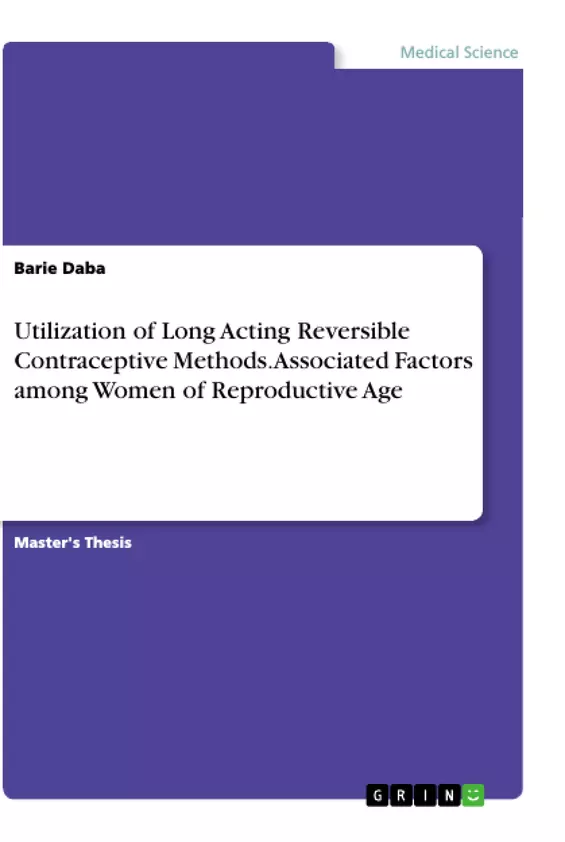This thesis assesses the utilization of long-acting reversible contraceptive methods and their associated factors among women of the reproductive age group in Bishoftu’s public health facilities. A health facility based cross-sectional study was conducted from March 16th to 30th 2020. A systematic random sampling technique was applied, in a total of 227 randomly selected women in the reproductive age group who attend Bishoftu’s public health facilities.
A structured questionnaire was developed using questionnaires that were applied in different studies related to family planning previously. The data was entered in a computer by using EPI-Info 7 version and cleaned then exported to SPSS version 20. Bivariate and multivariate logistic regression was employed to determine independent predictors of long acting and reversible contraceptive utilization.
WHO reports indicated that, in 2017 alone, over 295,000 maternal deaths that resulted from pregnancy and delivery related complication were reported worldwide indicating a decline of 45% from 1990. The sub-Saharan Africa region accounted for 62% of maternal death followed by South-Asian countries (24%). Provision of family planning is one of the most effective interventions that prevent unwanted and ill spaced pregnancies by reducing maternal mortality and morbidity. Given its effectiveness and associated fewer visits to health facilities, LARC are very important in tackling maternal mortality and morbidity. However, little is known regarding its prevalence in Bishoftu eastern Ethiopia.
Inhaltsverzeichnis (Table of Contents)
- Acknowledgement
- Acronyms/Abbreviations
- List of Tables
- List of Figures
- SUMMARY
- 1. Introduction
- 1.1. Background
- 1.2. Statement of the problem
- 2. Literature Review
- 2.1 Magnitude of utilization of modern contraceptive and long acting and Reversible contraceptive methods (LARCMs)
- 2.2 Factors affecting utilization of Long Acting and Reversible contraceptive methods
- 3. Significant of the study
- 3.1. Justification of the study
- 4. Objectives
- 4.1 General objective
- 4.2 Specific Objectives
- 5. Materials and Methods
- 5.1 Study area
- 5.2 Study period
- 5.3 Study design
- 5.4 Source population
- 5.5 Study population
- 5.6 Inclusion and Exclusion Criteria
- 5.7 Sample size Determination
- 5.8. Sampling procedure
- 5.10 Operational definition
- 5.11 Data Collection tools and procedures
- 5.12 Data processing and analysis
- 5.13 Data quality control
- 5.14 Ethical considerations
- 5.15 Data dissemination plan
- 6. Results
- 6.1 Socio-demographic characteristics of the respondents
- 6.2 Reproductive history of the respondent
- 6.3 Knowledge of respondents on modern contraceptive and LARMs
- 6.4 Methods preferred and reasons for not using LARMs among women in the reproductive age group
- 6.5 Factors affecting utilization of Long Acting and reversible contraceptive methods
- 6.6. Predictors of utilization of LARMs
- 7. DISCUSSION
- 8. STRENGTH AND LIMITATION
- 8.1 Strength
- 8.2 Limitation
- 9. CONCLUSION AND RECOMMENDATION
- 9.1 Conclusion
- 9.2 Recommendation
- Reference
Zielsetzung und Themenschwerpunkte (Objectives and Key Themes)
This thesis aims to explore the utilization of long-acting reversible contraceptive methods (LARCMs) among women of reproductive age in Bishoftu Public Health Facilities, Oromia, Ethiopia. The research seeks to understand the factors associated with the use of LARCMs and identify predictors influencing their adoption. The study investigates the prevalence of LARCM utilization, the reasons behind their choice or non-use, and the demographic, socioeconomic, and knowledge-related factors that contribute to their use. Key themes explored in the thesis include:- Prevalence and utilization patterns of LARCMs among women of reproductive age.
- Factors influencing the choice and non-use of LARCMs, including knowledge, attitudes, access, and socio-cultural beliefs.
- The association between demographic and socioeconomic characteristics and the utilization of LARCMs.
- Predictors of LARCM use, identifying the most significant factors impacting their adoption.
- Potential strategies and interventions to improve LARCM utilization and address identified barriers.
Zusammenfassung der Kapitel (Chapter Summaries)
- Chapter 1: Introduction: This chapter provides a comprehensive overview of the background, context, and rationale for the study. It highlights the importance of family planning, the role of LARCMs in achieving reproductive health goals, and the current status of LARCM utilization in Ethiopia. It also details the specific research problem and objectives.
- Chapter 2: Literature Review: This chapter presents a critical analysis of existing literature related to the utilization of LARCMs, focusing on global and regional trends, factors influencing their use, and the challenges associated with their adoption. The review examines the effectiveness, safety, and acceptability of different LARCMs, as well as the socio-cultural, economic, and health system factors influencing their use.
- Chapter 3: Significance of the Study: This chapter elaborates on the relevance and significance of the study, highlighting its contribution to understanding LARCM utilization in the specific context of Bishoftu Public Health Facilities. It emphasizes the study's potential to inform policy, program development, and service delivery improvements aimed at increasing LARCM uptake.
- Chapter 4: Objectives: This chapter outlines the general and specific objectives of the study. It clearly defines the research questions, aims, and intended outcomes.
- Chapter 5: Materials and Methods: This chapter provides a detailed description of the study design, setting, population, sampling methods, data collection procedures, and analysis techniques employed in the study. It also addresses ethical considerations and data quality control measures.
- Chapter 6: Results: This chapter presents the findings of the study, including descriptive statistics, frequency distributions, and analysis of factors associated with LARCM utilization. It examines the socio-demographic characteristics of the respondents, their knowledge, attitudes, and perceptions regarding LARCMs, and the influence of different factors on their use.
Schlüsselwörter (Keywords)
The primary keywords and focus topics of this thesis include family planning, long-acting reversible contraceptive methods (LARCMs), utilization, contraceptive prevalence rate, factors influencing utilization, demographic characteristics, socioeconomic factors, knowledge, attitudes, access, predictors of use, Bishoftu Public Health Facilities, Ethiopia.- Quote paper
- Barie Daba (Author), 2020, Utilization of Long Acting Reversible Contraceptive Methods. Associated Factors among Women of Reproductive Age, Munich, GRIN Verlag, https://www.grin.com/document/950115



